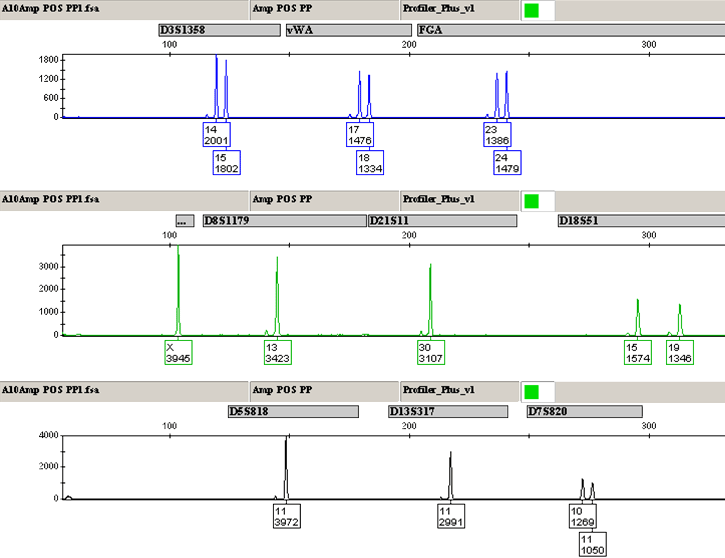Archival Notice
This is an archive page that is no longer being updated. It may contain outdated information and links may no longer function as originally intended.
Home | Glossary | Resources | Help | Contact Us | Course Map
Positive controls are included in most commercial DNA analysis kits used for quantitation or STR typing. A commonly used positive amplification control is 9947A which is a female cell line from a 31 year old Caucasian female. Some labs use other amplification controls including 007, 9948 or 2800M. Whichever one is used, it is usually amplified with each batch of samples and aids in determining the overall performance of the amplification and typing procedures.
The positive control should show the expected alleles. If no peaks are seen, this may indicate a problem with the amplification or injection. In the event that the positive control does not yield the correct results, analysts should troubleshoot the problem and follow the procedures established by the laboratory.
The positive control should show the expected alleles. If no peaks are seen, this may indicate a problem with the amplification or injection. In the event that the positive control does not yield the correct results, analysts should troubleshoot the problem and follow the procedures established by the laboratory.
Note: |
|---|
| It is expected that injection issues would have been identified in the internal size standard evaluation step. |
Additional Online Courses
- What Every First Responding Officer Should Know About DNA Evidence
- Collecting DNA Evidence at Property Crime Scenes
- DNA – A Prosecutor’s Practice Notebook
- Crime Scene and DNA Basics
- Laboratory Safety Programs
- DNA Amplification
- Population Genetics and Statistics
- Non-STR DNA Markers: SNPs, Y-STRs, LCN and mtDNA
- Firearms Examiner Training
- Forensic DNA Education for Law Enforcement Decisionmakers
- What Every Investigator and Evidence Technician Should Know About DNA Evidence
- Principles of Forensic DNA for Officers of the Court
- Law 101: Legal Guide for the Forensic Expert
- Laboratory Orientation and Testing of Body Fluids and Tissues
- DNA Extraction and Quantitation
- STR Data Analysis and Interpretation
- Communication Skills, Report Writing, and Courtroom Testimony
- Español for Law Enforcement
- Amplified DNA Product Separation for Forensic Analysts


